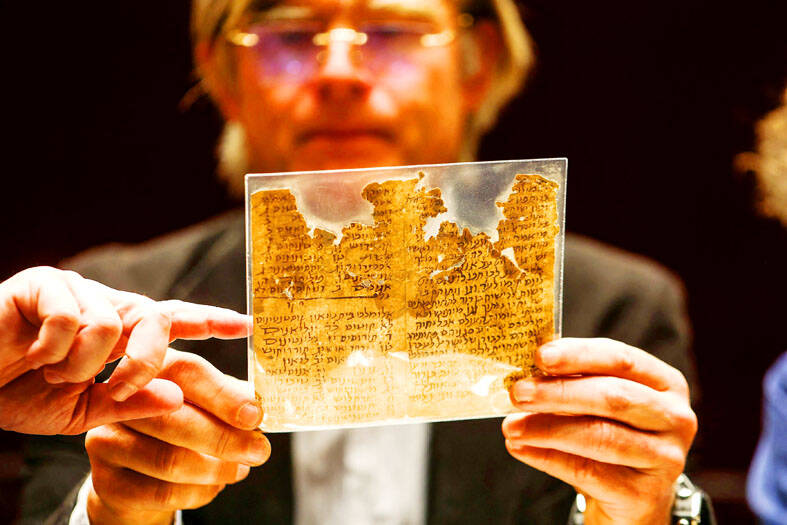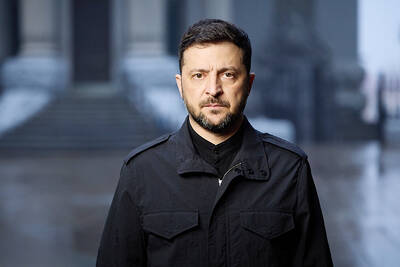Researchers in Israel are hoping to make new discoveries about Jewish history by loading a digital database of manuscripts stretching back 1,000 years into a new transcription tool that uses artificial intelligence (AI).
The Cairo Geniza, the biggest collection of medieval Jewish documents in the world, has been the object of hours of study by academics for more than a century, but not a lot of its more than 400,000 documents have been thoroughly researched.
Although the entire collection has already been digitized and is available online in the form of images, most of its items have not been catalogued, and many are disordered fragments from longer documents.

Photo: Reuters
Only about one-10th have transcriptions.
By training an AI model to read and transcribe the old texts, researchers would be able to access and analyze the whole collection far more quickly, cross referencing names or words and assembling fragments into fuller documents.
“We are constantly trying to improve the abilities of the machine to decipher ancient scripts,” said Daniel Stokl Ben Ezra of the Ecole Pratique des Hautes Etudes in Paris, one of the principal researchers in the MiDRASH transcription project.
The project has already made significant progress and could open up the documents — which are written in Hebrew, Arabic, Aramaic and Yiddish in a wide variety of handwritten scripts — to many researchers, Stokl Ben Ezra said.
Transcriptions from more difficult manuscripts are reviewed by researchers for accuracy, helping to improve the AI training.
“The modern translation possibilities are incredibly advanced now and interlacing all this becomes much more feasible, much more accessible to the normal and not scientific reader,” Stokl Ben Ezra said.
Funded by the European Research Council, the project is based on the National Library of Israel’s digital database of the Cairo Geniza documents and brings together researchers from several universities and other institutes.
One document transcribed by the project is a 16th-century letter in Yiddish from Rachel, a widow from Jerusalem, to her son in Egypt with his reply written in the margins telling of his efforts to survive a plague sweeping through Cairo.
A Geniza is a synagogue’s repository for significant documents that are ultimately intended for ritual burial. The one found in the Ben Ezra synagogue in historic Cairo had a dry atmosphere ideal for the preservation of old paper.
Cairo surpassed Damascus and Baghdad in the Middle Ages as the greatest city of the Middle East, a center of global trade, learning and science and home to a thriving Jewish community, later expanded by refugees fleeing Spain.
The great Jewish philosopher Maimonides, who was physician to the family of Saladin, the Muslim sultan who ousted the crusaders from Jerusalem, worshipped at the Ben Ezra synagogue while living in Cairo.
As dynasties and empires rose and fell, the community quietly went about its daily life, its religious authorities filling the Geniza with the rabbinical arguments, civic records and other detritus of administrative and intellectual business.
The Geniza’s haul of records and papers, including some written by Maimonides himself, was discovered by academics in the late 19th century, but although it has been studied ever since, its enormous size means that huge gaps remain.
“The possibility to reconstruct, to make a kind of Facebook of the Middle Ages, is just before our eyes,” Stokl Ben Ezra said.

DISASTER: The Bangladesh Meteorological Department recorded a magnitude 5.7 and tremors reached as far as Kolkata, India, more than 300km away from the epicenter A powerful earthquake struck Bangladesh yesterday outside the crowded capital, Dhaka, killing at least five people and injuring about a hundred, the government said. The magnitude 5.5 quake struck at 10:38am near Narsingdi, Bangladesh, about 33km from Dhaka, the US Geological Survey (USGS) said. The earthquake sparked fear and chaos with many in the Muslim-majority nation of 170 million people at home on their day off. AFP reporters in Dhaka said they saw people weeping in the streets while others appeared shocked. Bangladesh Interim Leader Muhammad Yunus expressed his “deep shock and sorrow over the news of casualties in various districts.” At least five people,

ON THE LAM: The Brazilian Supreme Court said that the former president tried to burn his ankle monitor off as part of an attempt to orchestrate his escape from Brazil Former Brazilian president Jair Bolsonaro — under house arrest while he appeals a conviction for a foiled coup attempt — was taken into custody on Saturday after the Brazilian Supreme Court deemed him a high flight risk. The court said the far-right firebrand — who was sentenced to 27 years in prison over a scheme to stop Brazilian President Luiz Inacio Lula da Silva from taking office after the 2022 elections — had attempted to disable his ankle monitor to flee. Supreme Court judge Alexandre de Moraes said Bolsonaro’s detention was a preventive measure as final appeals play out. In a video made

SHOW OF FORCE: The US has held nine multilateral drills near Guam in the past four months, which Australia said was important to deter coercion in the region Five Chinese research vessels, including ships used for space and missile tracking and underwater mapping, were active in the northwest Pacific last month, as the US stepped up military exercises, data compiled by a Guam-based group shows. Rapid militarization in the northern Pacific gets insufficient attention, the Pacific Center for Island Security said, adding that it makes island populations a potential target in any great-power conflict. “If you look at the number of US and bilateral and multilateral exercises, there is a lot of activity,” Leland Bettis, the director of the group that seeks to flag regional security risks, said in an

‘DIGNITY’: The Ukrainian president said that ‘we did not not betray Ukraine then, we will not do so now,’ amid US pressure to give significant concessions to Russia Ukrainian President Volodymyr Zelenskiy on Friday pushed back against a US plan to end the war in Ukraine, while Russian President Vladimir Putin welcomed the proposal that includes many of his hardline demands. With US President Donald Trump giving Ukraine less than a week to sign, Zelenskiy pledged to work to ensure any deal would not “betray” Ukraine’s interests, while acknowledging he risked losing Washington as an ally. Putin said the blueprint could “lay the foundation” for a final peace settlement, but threatened more land seizures if Ukraine walked away from negotiations. Ukraine faces one of the most challenging moments in its history,